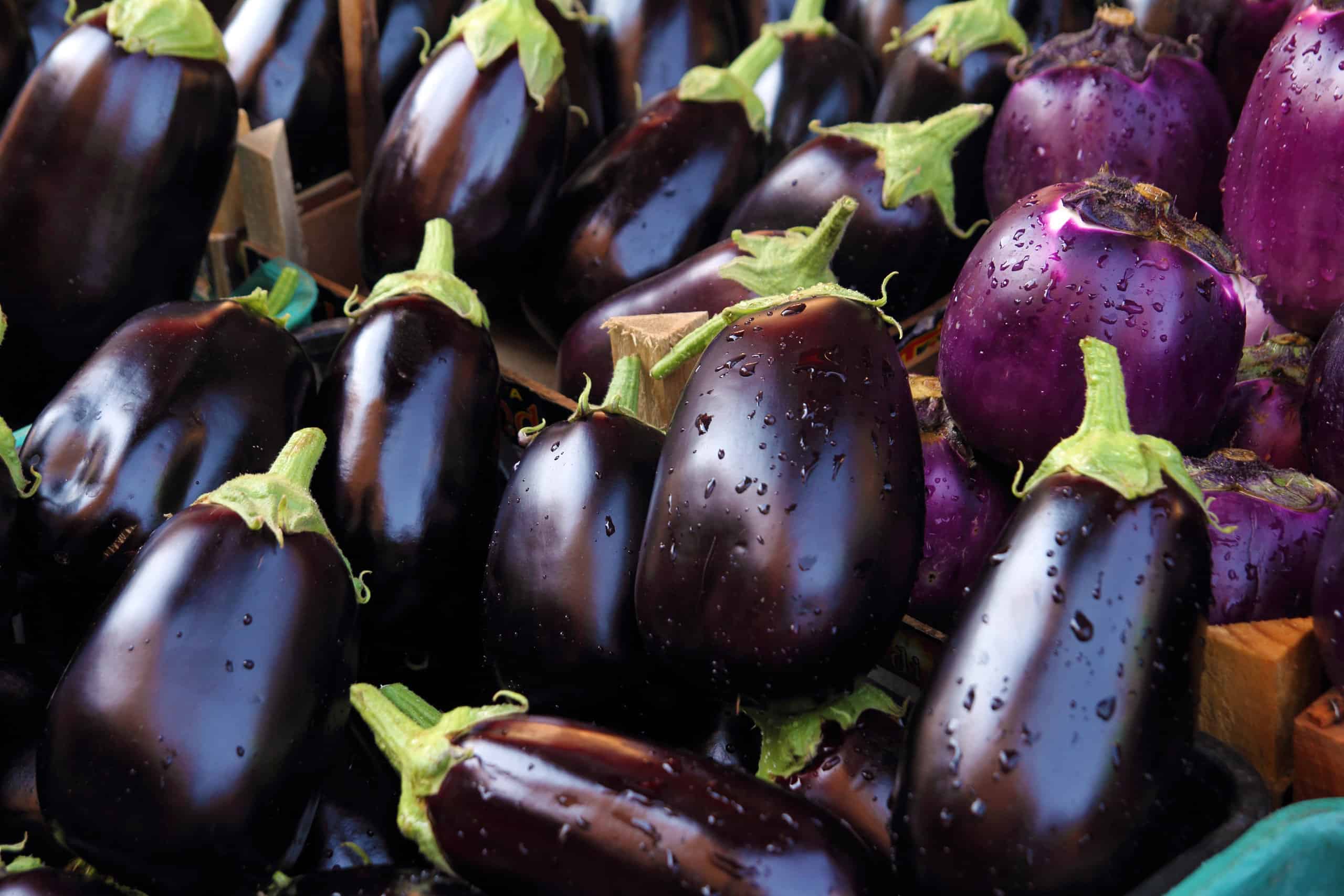Who doesn’t like purple vegetables? It may seem an exotic color, but there are an amazing number of veggies that can come in shades of purple. What causes a vegetable to become purple? Vegetables get their purple color from anthocyanins, which are pigments. Some nutritionists believe that plants high in anthocyanins have antioxidant properties. These properties protect against such maladies as cancer, inflammation, and cardiovascular disease. With that in mind, here are some purple veggies to enjoy.
1. Eggplant
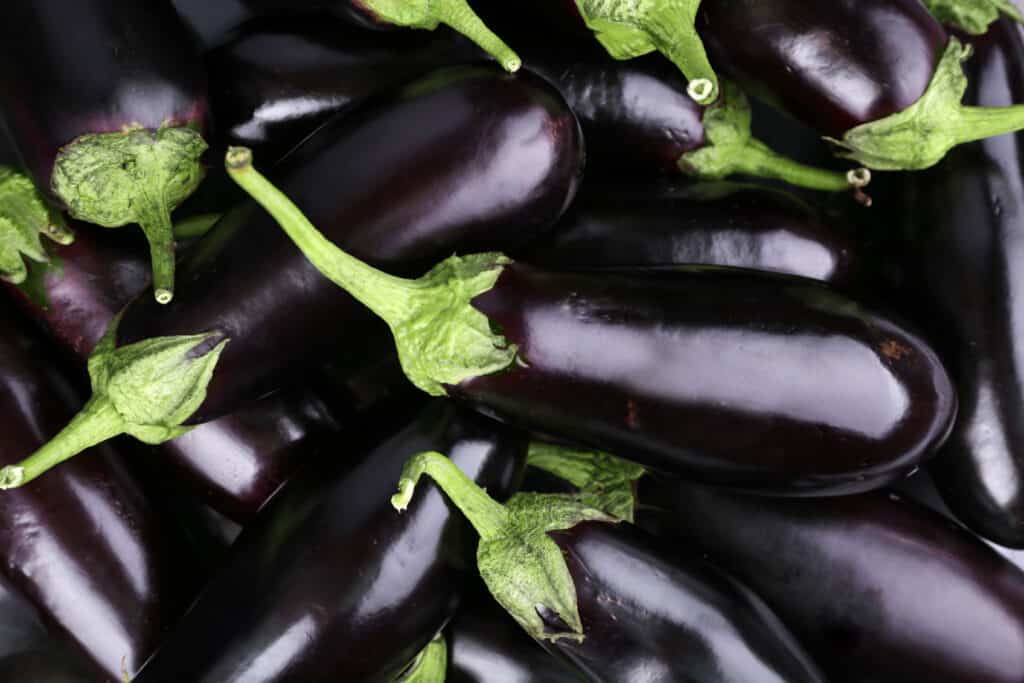
Look for eggplants that are firm, glossy, and unbruised.
©Africa Studio/Shutterstock.com
Most people are familiar with the glossy, fat Italian eggplant and even its skinnier Japanese relative. Unlike most of the other purple vegetables listed, only the skin of the eggplant is purple, while the flesh is creamy. Still, young and tender eggplants are often cooked with their skin on. It makes a nice contrast with its light flesh.
Eggplants are members of the nightshade family along with potatoes and tomatoes. This means the plant’s leaves, stems and pretty flowers are poisonous thanks to an alkaloid called solanine. Only the fruit (which is used as a vegetable) is really safe to eat. For centuries, people were wary of eating it. The Chinese were the first to brave it, probably around the 6th century A.D. Back then, the vegetable did look like an egg, for even its skin was white and lustrous. It was also small. As the eggplant traveled around the world it grew bigger. Eventually, it took on its famous purple color, though there are still white eggplants.
Eggplant is fantastic in casseroles and stews because it takes on the flavors of what it’s cooked with. Though the vegetable isn’t particularly vitamin-rich, it is full of minerals such as calcium, magnesium, and potassium. It’s also abundant in amino acids, which go into making proteins.
2. Onions
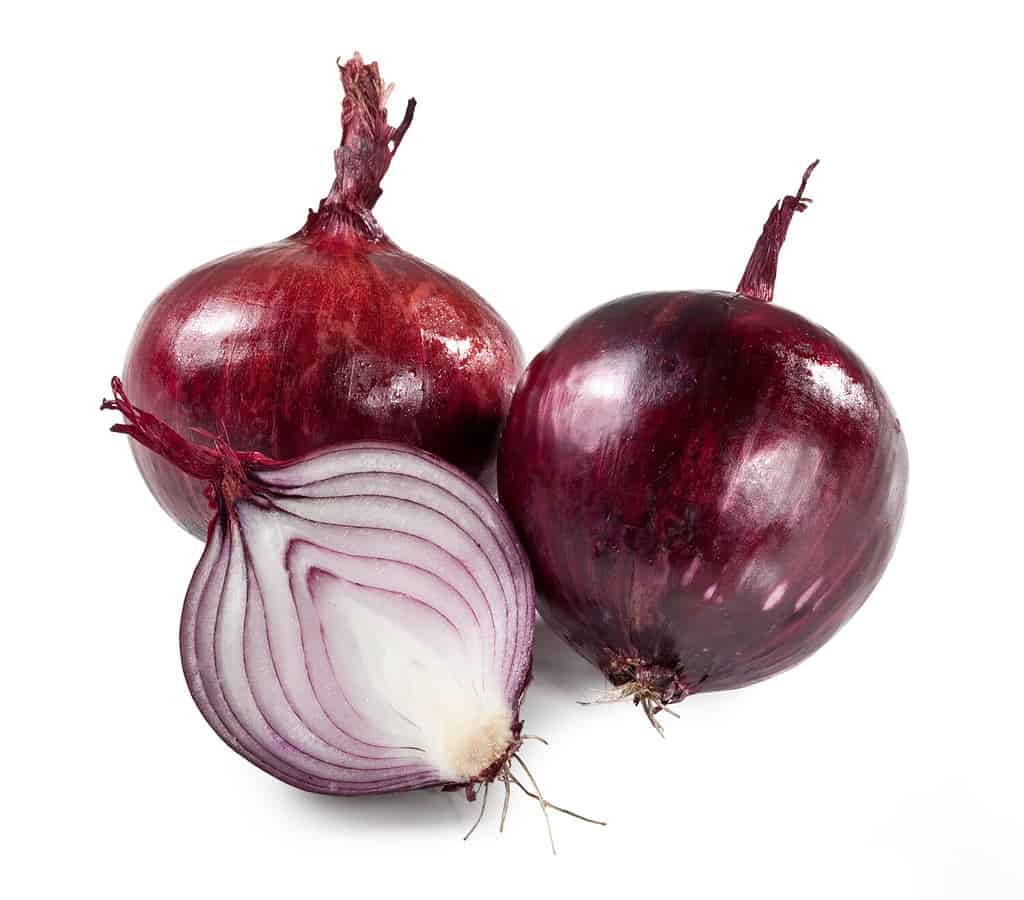
Red onions tend to be milder than yellow onions.
©Italian Food Production/Shutterstock.com
Red onions and their smaller cousins, shallots, are actually purple. The purple of the red onion can be seen immediately in its skin, but you have to peel the shallot to see the lovely heliotrope of its flesh. Unlike the eggplant and the tomato, the onion’s worth has been recognized since antiquity. People not only ate it but revered it as a sacred object. Red onions are considered much milder than yellow or white onions and can be tossed in salads or dressings. Shallots are even sweeter but when peeled and cut can make you cry as much as any large yellow onion. They’re also great for stir-fries, dressings, and vinaigrette.
Onions are notoriously healthy vegetables, and red onions and shallots may be healthier still thanks to their anthocyanins. They are rich in potassium, phosphorus, and vitamins. Good varieties of red onions include Red Mountain, Red Candy Apple, and Monastrell.
3. Cabbage
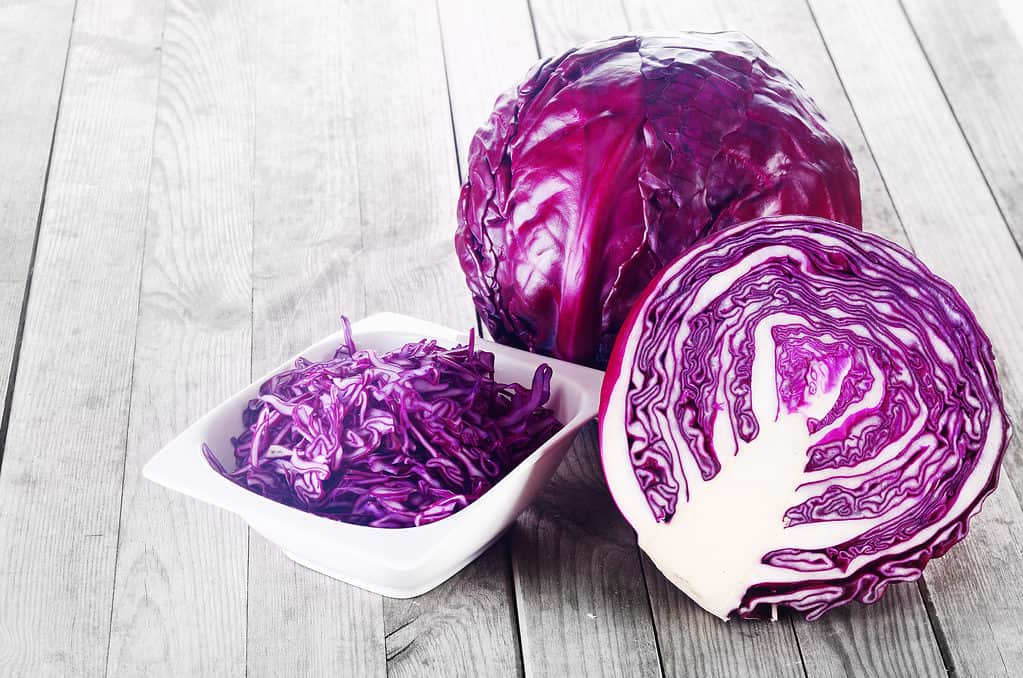
Purple cabbage stays purple even after it’s cooked.
©stockcreations/Shutterstock.com
One of the many good things about purple cabbage is that it holds on to its color even after it’s cooked. This gives any dish an elegant and somewhat exotic look. Like the onion, cabbage has been enthusiastically eaten for thousands of years. Red cabbage is sweeter than the original green varieties, and it has more calories. By the way, if you grow any type of cabbage and want to increase its sweetness, wait till a frost to harvest it. Red cabbage is rich in potassium and is mostly water. You can eat all you want without having to watch your weight. Varieties of red cabbage include Ruby Ball Improved and Red Empress.
4. Cauliflower
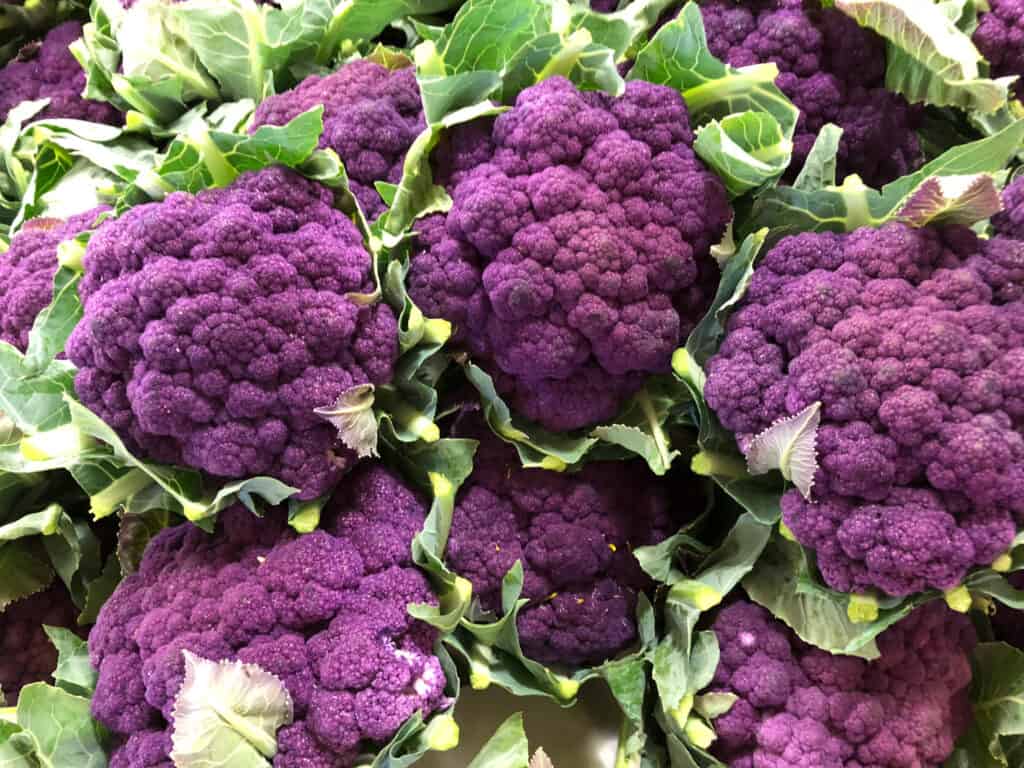
Here’s a group of eye-catching purple cauliflower for sale at the market.
©iStock.com/MartinPBGV
Cauliflower is one of the many brassica vegetables descended from the cabbage. Though most people are familiar with the white, brainy-looking head in its ruff of green leaves, there are purple cauliflowers. Like its ancestor, the cauliflower is full of nutrients, including vitamins A, folic acid, and vitamin C as well as potassium and phosphorus. The best time to buy cauliflower is in the fall or winter when it’s ready for harvest. Cauliflower bought during the spring or summer is out-of-season and may have been kept in cold storage. The trick is to soak the cauliflower in cold water for about a half an hour then boil in a pot of water with about a teaspoon of white vinegar. If you can’t find purple cauliflower in the store and want to grow it, DePurple and Purple of Sicily are good varieties.
5. Tomatoes
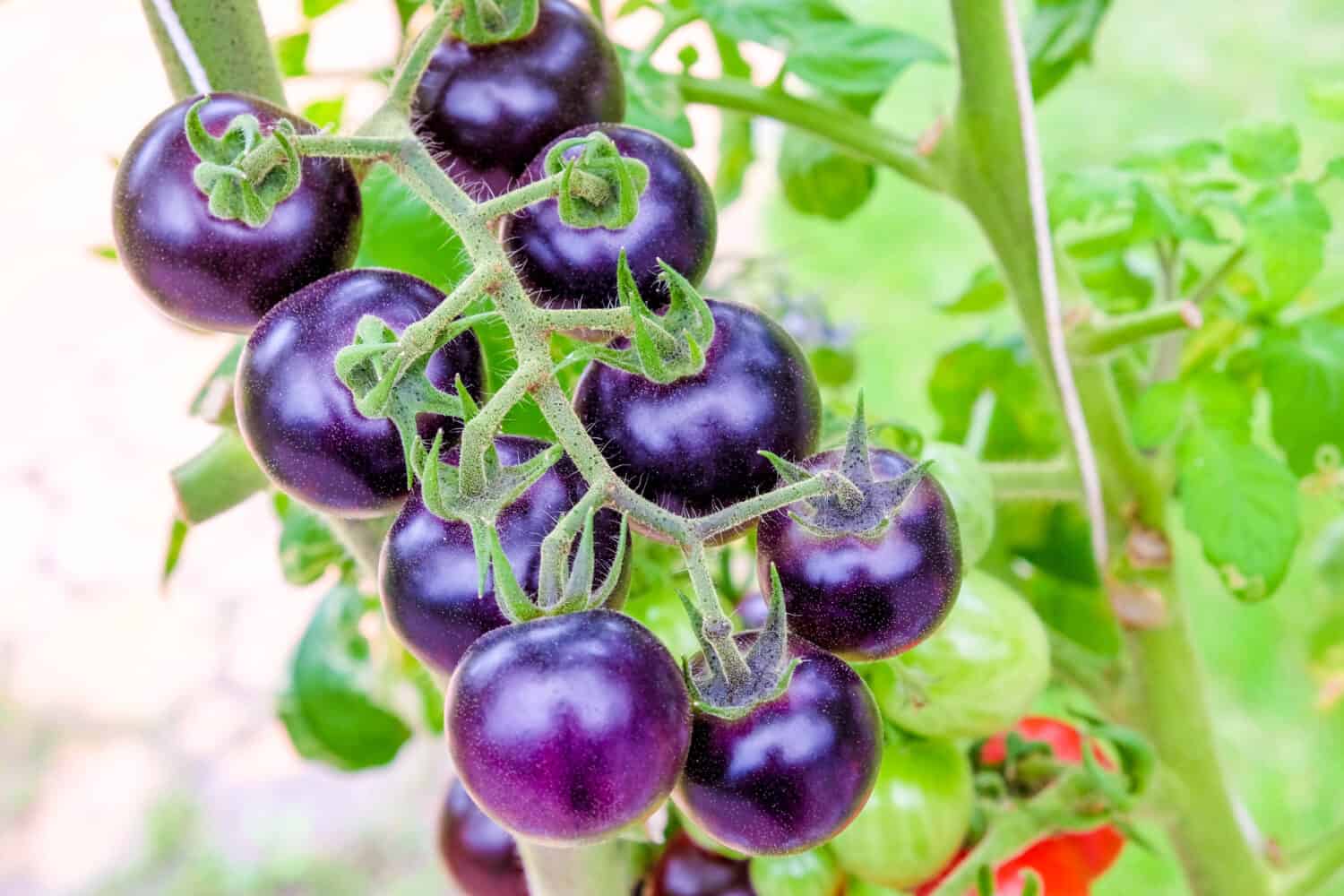
All tomatoes are best when they’re left to ripen on the vine.
©Nattapol_Sritongcom/Shutterstock.com
The humble but needful tomato, shunned for centuries like the eggplant as a member of the nightshade family, now comes in a wealth of colors besides glorious tomato red. There are orange tomatoes, yellow tomatoes, tomatoes with green stripes like little watermelons, and of course purple tomatoes. These bear names like Chocolate Cherry, Purple Zebra, Purple Boy, and Purple Russian. Despite its prevalence in Mediterranean cooking, the tomato is native to the Americas. The Incas, Mayans, and Aztecs cultivated the plant and the Aztecs actually gave it its name of tomatl. Eventually, the conquistadors brought the plant, and other plunder, back to Spain. Once there it was feared and admired as an aphrodisiac. Like purple cauliflower, purple tomatoes may be hard to find in the supermarket, and your best bet is to grow them yourself. Tomatoes can even be cultivated in a pot in a sunny window.
Whatever their color, the best tomatoes are allowed to ripen slowly in the sun, on the vine. Tomatoes are low in calories and immensely healthful. They’re rich in vitamins A, C, and potassium.
6. Potatoes

Potatoes even purple ones, are native to the Andean Mountains.
©Olga Bondas/Shutterstock.com
Like the tomato, the potato is native to the Americas, specifically the Peruvian Andes, and is also a member of the nightshade family. This means its leaves and flowers are poisonous. Also poisonous is its fruit, which resembles a green tomato. What we eat of the potato plant is its tuber, which grows underground. The Incas figured this out about 3000 years ago, but once the potato arrived in Europe it was reviled — until it wasn’t. It was soon a staple throughout Europe, and then it was a staple throughout North America.
Folks who enjoy purple potatoes claim that their flavor is earthier than that of the white potato, and they certainly stand out in a dish. Like purple cabbage, these vegetables hold on to their color even after they’re cooked. Like other potatoes, purple potatoes are nutritious. They’re full of protein, carbohydrates, vitamin B6 and vitamin C, and fiber along with minerals such as copper, iron, manganese, and a hefty helping of potassium. Best of all, a 3.5 ounce serving of a purple potato in its jacket has less than a gram of fat. Varieties of purple potatoes include Huckleberry Gold, Magic Molly, and Adirondack Blue.
7. Okra
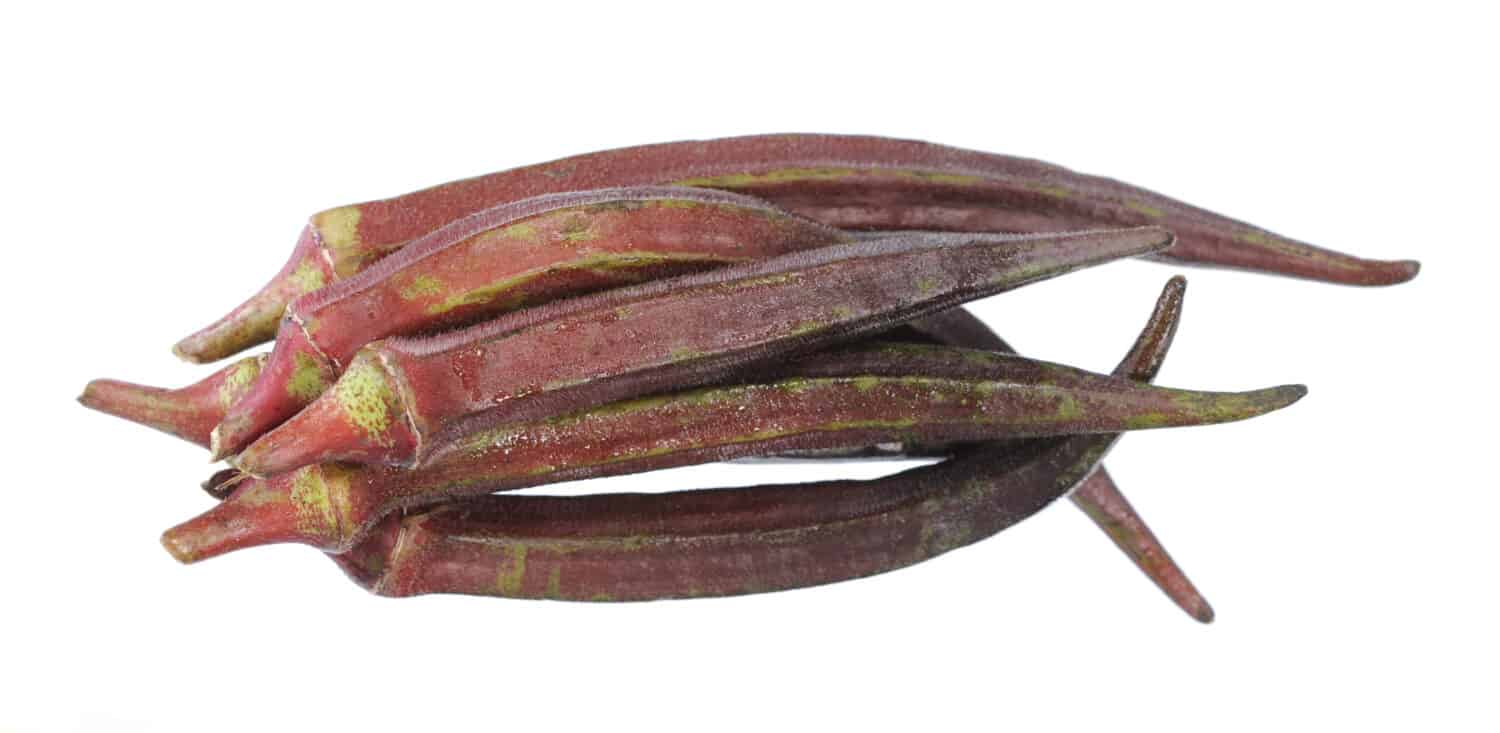
Don’t wait till okra are this long to pick them. They should be no longer than your finger.
©AN NGUYEN/Shutterstock.com
People who eat okra are familiar with the green seed pods that grow from beautiful lemon-yellow flowers with purple throats. There are purple varietals of okra as well. People aren’t sure where okra originated, but they certainly came to America with enslaved people from West Africa. It’s a plant that thrives in hot climates, and in the warmer hardiness zones is a perennial. This means it comes back year after year.
Okra pods need to be picked and eaten when they are young, probably no longer than a finger, otherwise they become tough. Famously, the pods are mucilaginous, or frankly, slimy. This is off-putting to some people but shouldn’t be. One trick is to cook the okra with tomatoes, which are acidic enough to keep the slime to a minimum. The best news is that okra and tomatoes were meant for each other. The vegetables are the stars of dishes such as gumbos, jambalayas, and optimist’s salad. Okra is rich in vitamins, including the B vitamins, vitamins A, C, E, and K, and minerals such as iron magnesium, calcium, potassium, phosphorus, and zinc. Unlike the members of the nightshade family, the leaves and flowers of the okra plant are edible. Good varietals of purple okra include Candle Fire and Burgundy.
8. Corn
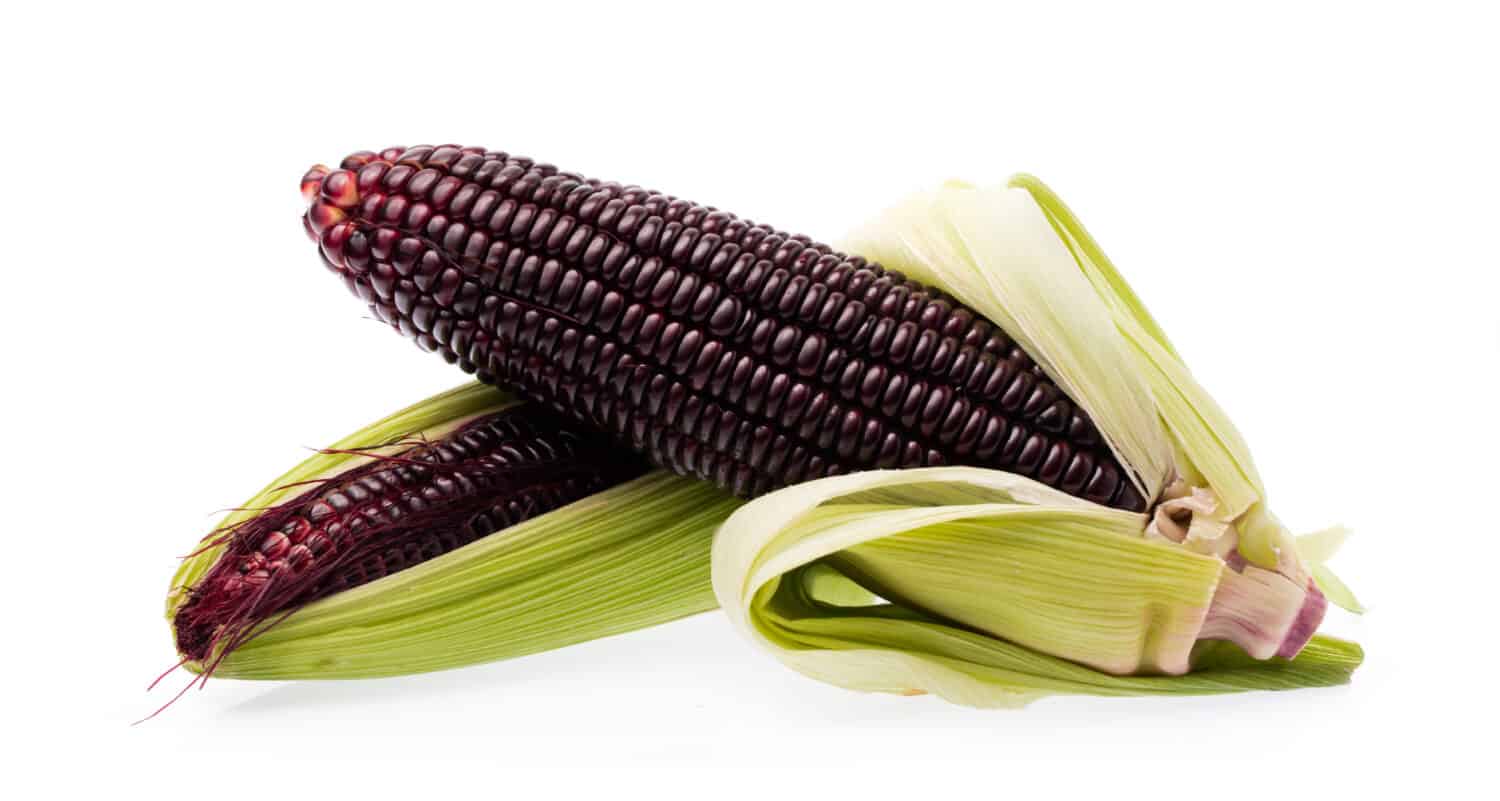
You can use purple corn to make cornmeal.
©Yellow Cat/Shutterstock.com
Purple corn or purple maize is native to South America, and like the potato, it’s found in the Andes. It’s used to make a drink called chicha morada. This drink has been enjoyed since before the time of the founding of the Inca Empire and the arrival of Christopher Columbus. It can be made in the traditional way, which involves boiling the corn with pineapple, quince, and spices. You can also whip it up quickly by simply adding water to a powder. If corn starch is added, it turns into a pudding called mazamorra on which fruit is sprinkled.
But you don’t have to go to the Andes to enjoy purple corn. You can grow a corn called Hooker’s Sweet Indian which is used to make cornmeal and a purple popcorn called Dakota Black.
9. Carrots
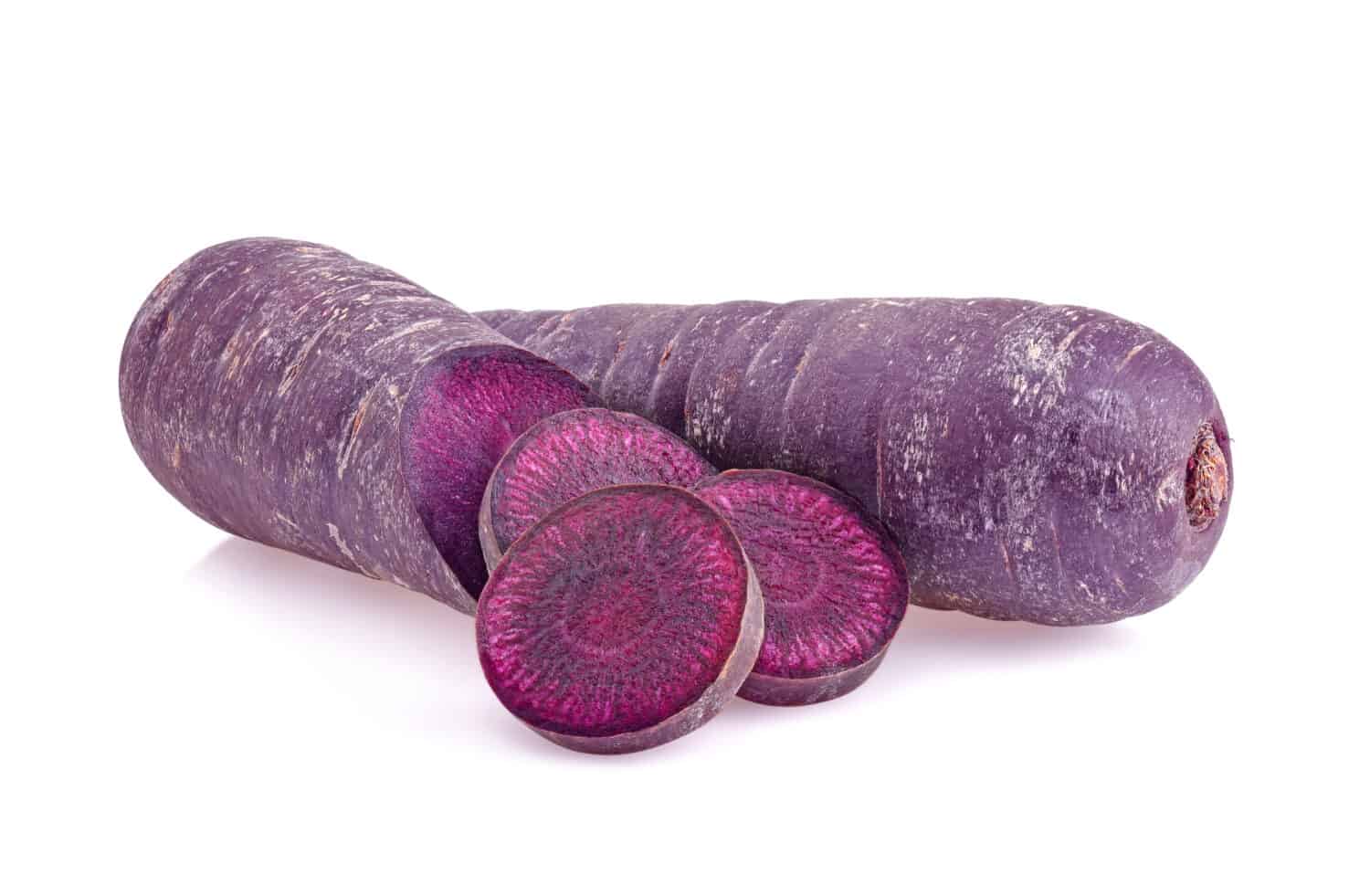
Purple carrots are purple all the way through.
©akepong srichaichana/Shutterstock.com
Carotenoids make carrots orange, but anthocyanins make carrots purple. What most people don’t know is that carrots were originally purple and were largely used medicinally. Specifically, their leaves and seeds were used. Historians believe it was the ancient Romans who started to cook and eat the root. Some people believe that carrots weren’t reliably orange until the Dutch started to experiment with them. They wanted to turn them the color of the Dutch royal house, or the House of Orange. Other folks find this apocryphal.
Though purple carrots don’t have as much beta carotene as orange carrots, they are still rich in this nutrient. They also have lots of fiber, manganese, and potassium. Purple carrots you might want to grow include Purplesnax, Purple Sun, and Dragon.
10. Artichokes
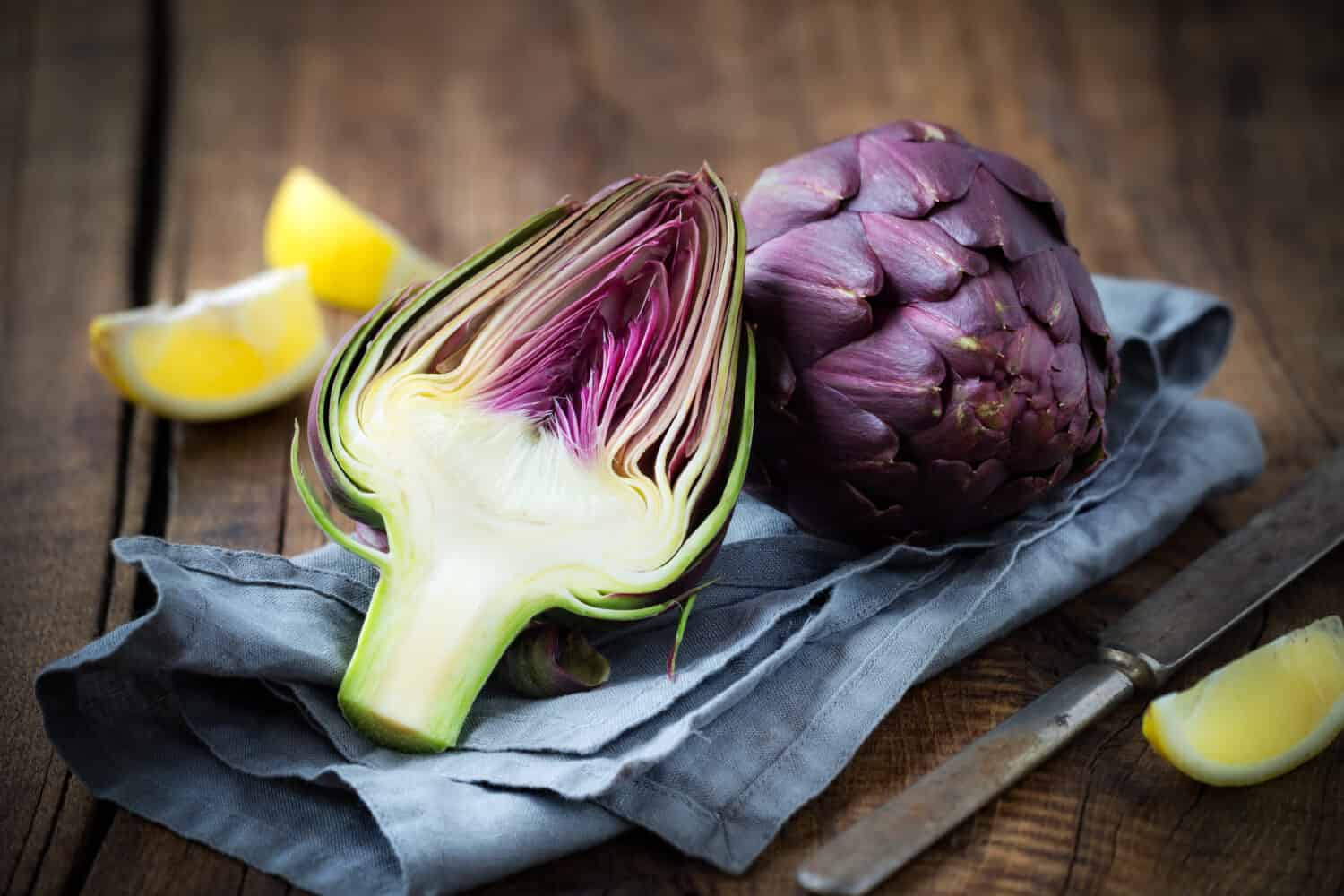
The artichoke is a giant thistle that hasn’t opened yet.
©kuvona/Shutterstock.com
The artichoke is actually the bud of a giant thistle, and they come in shades of purple as well as green. If you slice even a green artichoke in half, you’ll find that some of the leaves have purple tips. It’s native to the Mediterranean area, and small artichokes are eaten raw. Prepare larger ones by removing most of the stem, thorns, and needles in the choke then steam or boil for about 20 minutes. Then pull the leaves off and dip them in melted butter or vinaigrette sauce. A 3.5 ounce serving of artichoke is mostly made of water, but has 2.87 grams of fat and is rich in Vitamin A and the B vitamins, including riboflavin and folic acid. The artichoke is also a good source of minerals such as magnesium, copper, calcium, phosphorous, and sodium. Purple varieties of artichoke include Romanesco, Violet d’Algerie, and Violetto.
11. Asparagus
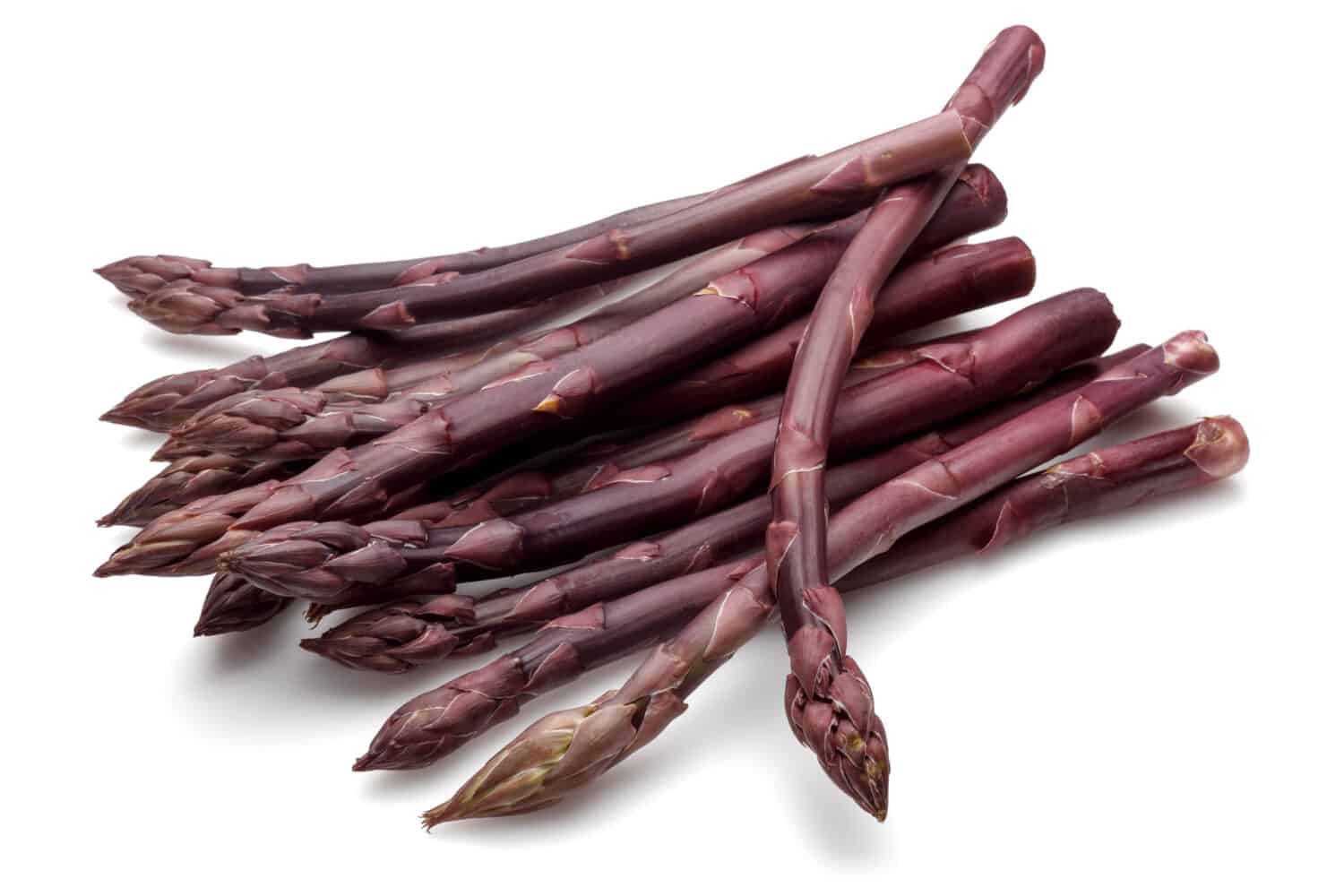
Here’s a bunch of beautiful purple asparagus.
©mahirart/Shutterstock.com
A welcome sight in the supermarket during spring, asparagus tends to be pricey. This is because it takes at least two years before they’re harvested. Asparagus has been enjoyed since the time of the ancient Egyptians, but back in the day, the vegetable was tiny and delicate. It was the ancient Romans who made asparagus more robust, to the point where its name is derived from the Greek word for “as long as your throat,” or aspharagos.
Green varieties of asparagus are most often seen, but there are also white and purple kinds. Asparagus is fantastic boiled, steamed, or roasted, and people eat young and tender stalks raw. They’re also great hot, cold, or room temperature served with velvety sauces. The rumor that asparagus affects the smell of your urine surprisingly soon after you’ve eaten some is true. But it’s worth it for the taste of the vegetable and the nutrients it packs. They include a whopping amount of vitamin A, vitamin C, and B vitamins. Plus, a cup of cooked asparagus has only 35 calories. Purple cultivars of asparagus include Purple Passion and the Erasmus Hybrid.
12. Peppers
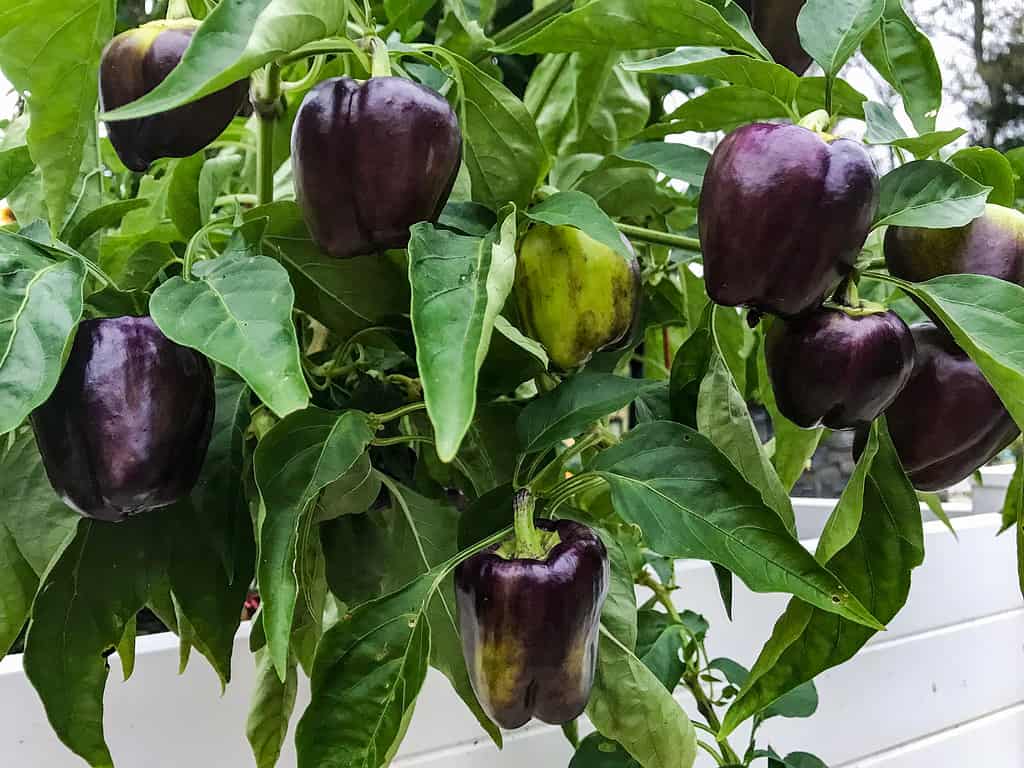
Here’s a bush full of purple bell peppers.
©ButtermilkgirlVirginia/Shutterstock.com
Peppers are members of the nightshade family and so everything about the plant but the fruit is poisonous. What sets peppers apart from most other plants, nightshade or not, is the heat. This is caused by a compound called capsaicin, found in the seeds and the ribs. Heat ranges from the negligible heat of sweet bell peppers to the nearly intolerable flame of the Ghost chili. This hot pepper is ranked at over one million on the Scoville heat scale. There’s a type of pepper for every palate, including palates that prefer the purple varieties.
Like potatoes and tomatoes, peppers are indigenous to America. Columbus was so enamored of them that he had the entire hold of one of his ships stuffed with them. They were what really made him famous in Europe.
Sweet bell peppers, the ones used as a vegetable as opposed to a spice, are low in calories and high in vitamins A and C and amino acids. They also have a good amount of minerals such as potassium, calcium, iron, and magnesium. Peppers are easy to grow. They benefit from a spritz of Epsom salt water now and then and phosphorus matches tucked into the soil. Purple varieties of peppers include Dragonfly, Purple Sweetie, and Purple Beauty.
13. Beets
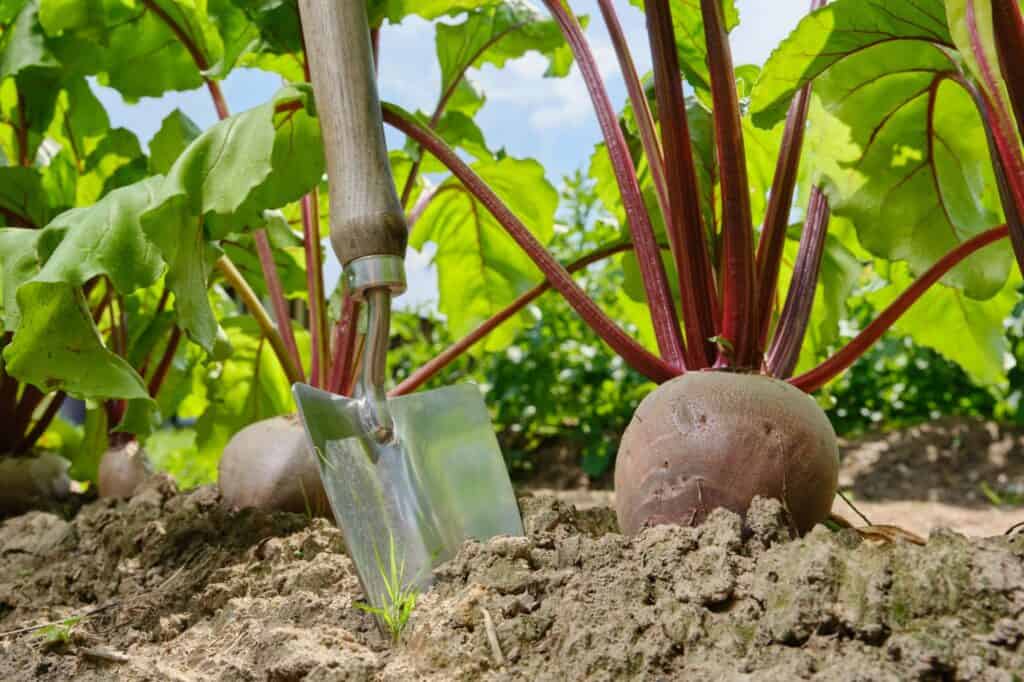
You can eat both the root and green leaves of the beet.
©Vlad Antonov/Shutterstock.com
Of course, the beet is the ultimate purple vegetable. Beets that are not some shade of red or purple are the ones that are unusual. Like a good number of vegetables, the ancients didn’t actually eat the beet root but concentrated on the beet greens. Actually, beet greens are also good and are super rich in vitamin A, calcium, and potassium. However, back in the day, the beet root was used only medicinally or by soothsayers. The beet root has plenty of vitamin A, B complex vitamins, vitamin C, and minerals such as potassium, calcium, iron, and zinc. It’s fantastic whether roasted or boiled. One trick is to plunge beets into ice water after they’re done to make it easy to slip off the skin.
14. String Beans

These purple string beans are ready to be cooked.
©Brent Hofacker/Shutterstock.com
People have cultivated string beans to no longer have strings, for the most part. You may be surprised that the string bean is, like so many members of the nightshade family, native to the Americas. It’s not a nightshade, but the Spanish conquistadors collected it and brought it back to Europe. Interestingly, though Native Americans had been eating string beans for millennia, the Spanish didn’t bring the plants back as food. Originally, the string bean was an addition to the flower garden. The pods were considered ornamental. According to legend, one day a bunch of them fell into a pot of soup, the cook decided to leave them in, and the rest is history. Another odd fact is that string beans have only been grown in the United States, commercially at least, since the 19th century.
Though string beans are called green beans by many people, they come in a variety of colors, including purple. Whatever color, they’re good for you with their abundance of potassium, phosphorus, calcium, and vitamin A. Good varieties of purple string beans are Carminat, Purple Queen Improved, Maxibel, and Venture.
15. Lettuce
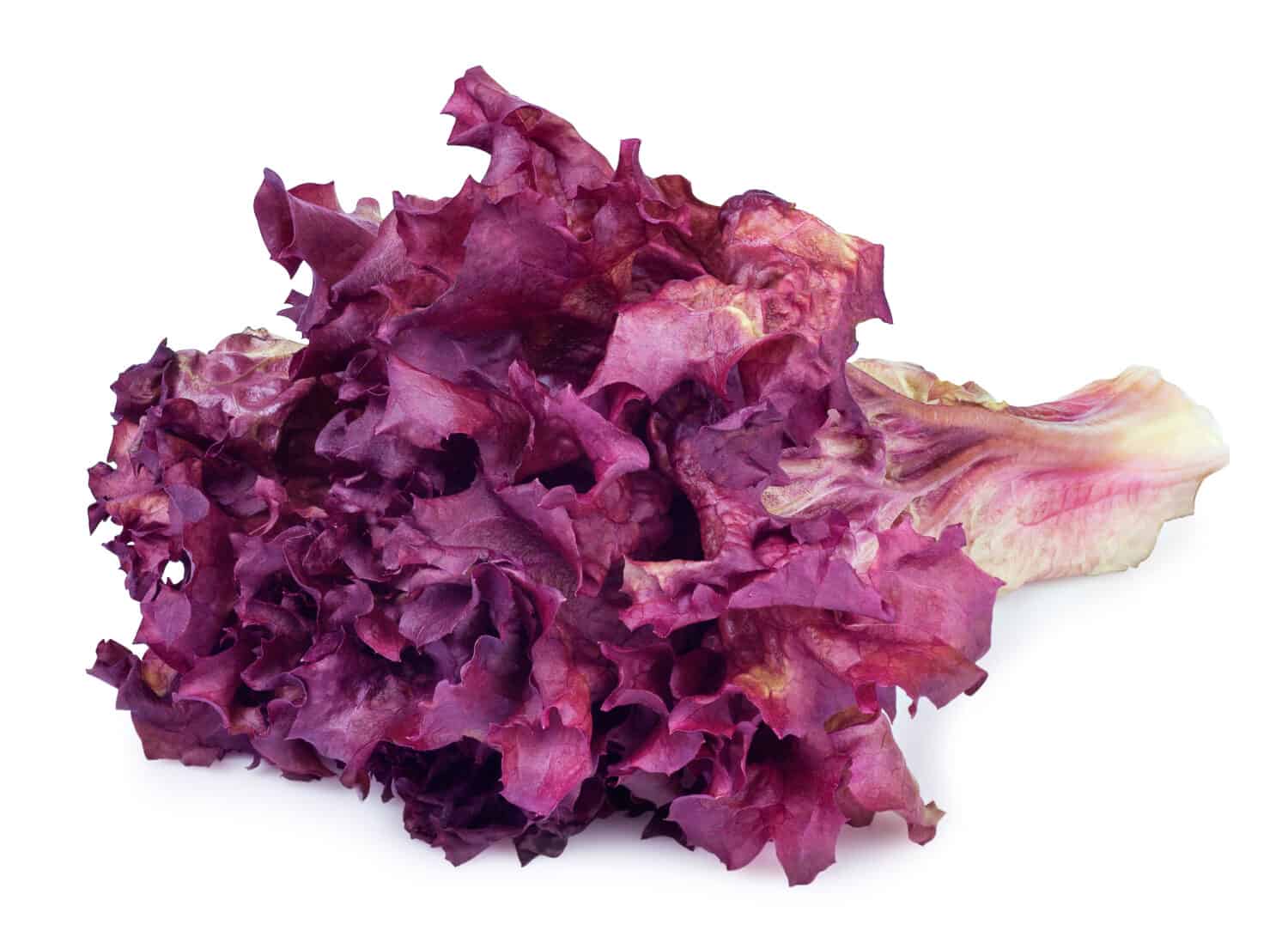
Adding purple lettuce to a salad makes that salad pop.
©Alter-ego/Shutterstock.com
When people think of lettuce, they think of a vegetable that’s cool, crisp, crunchy, and green. They also think of something that is so low in calories that they could probably eat a whole head without having to worry about their diet. This is true. A 3.5 ounce serving of lettuce brings only 13 calories along with B vitamins, vitamins K, C, and E, and lots of minerals.
There are all kinds of lettuce, and they’re not just for salads. They range from the loose-leaf types of lettuce with open heads to Romaine lettuce, named because their long leaves reminded people of Roman spoons, to butterhead, and French crisp. Their leaves are blanched, wrapped around cheese, then baked. They make sandwiches interesting. They’re torn up and tossed into soups at the last minute, or added to a tomato and onion stew. Purple varieties of lettuce include Black Hawk, Red Salad Bowl, Merlot, Skyphos, and Alkindus.
Thank you for reading! Have some feedback for us? Contact the AZ Animals editorial team.

